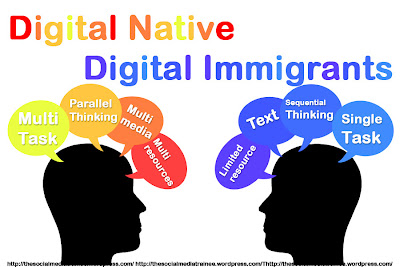Digital Immigrant teachers and Digital Native students as categorized by
the author
Digital Natives and Digital Immigrants are two
groups that are formed through knowing technology, and not knowing
technology. The groups are generally formed by the year that the person
was born in as this averagely changes their understanding of technology.
They are different also due to their knowledge of technology and how well they
are able to pick up new skills. Educators must be wary of which
generation they are teaching, although now it is mostly Digital Natives, so
they should teach in a way that appeals to this adapted learning style.
Therefore, current teachers should use more technology in their teaching to
help the children learn faster, better and more successfully.
Overview
A digital native refers to an individual who has grown up using
technology and is considered a “native speaker” of electronic media's
digital language. This generation of learner multi-tasks efficiently,
works quickly, and favors interactivity while learning. ( Prensky )
A digital immigrant is someone who was not raised in a digital environment but still uses and adopts many aspects of technology. ( Prensky )
Here is a mind map image that someone create it to describes the differences between Digital Natives and Digital Immigrants
Two Different Views of Tweeting
To summaries the differences between digital natives and digital
immigrants which were discussed in the two articles a mind map was
created using the graphic organizer, Inspiration.
Differences between Digital Immigrant teachers and Digital Native students
Digital
Immigrant teachers, the people
sitting in their classes grew up on the “twitch speed” of video games and MTV.
They are used to the instantaneity of hypertext, downloaded music, phones in
their pockets, a library on their laptops, beamed messages and instant
messaging. They’ve been networked most or all of their lives. They have little
patience for lectures, step-by-step logic, and “tell-test” instruction.
Digital
Immigrant teachers assume that learners are the same as they have always been,
and that the same methods that worked for the teachers when they were students
will work for their students now. But that assumption is no longer valid.
The
Digital Natives will go backwards. In
the first place, it may be impossible – their brains may already be different.
It also flies in the face of everything we know about cultural migration. Kids
born into any new culture learn the new language easily, and forcefully resist
using the old.
Digital
Natives’ brains are likely physically different as a result of the
digital input they received growing up.
(2003) chart outlines the key differences between digital native learners and their digital immigrant teachers.(Wikis website)
Digital immigrant accent
The “digital immigrant accent” can be seen in such things as turning to the Internet for information second rather than first, or in reading the manual for a program rather than assuming that the program itself will teach us to use it.
"The
digital immigrant accent includes going slowly, going step-by-step, using
outlines for
organization,
reading manuals, going to the internet second rather than first. Digital
natives find this accent and approach very hard to deal with" Marc Prensky in an elearning post interview.
Funny examples
The biggest serious problem facing education today
The
single biggest problem facing education today is that our Digital
Immigrant instructors, who speak an outdated language (that of the pre-digital
age), are struggling to teach a population that speaks an entirely new
language.
Should the Digital Natives learn the old way, or should their Digital Immigrants learn the new?
Unfortunately, no matter how much the Immigrants may wish it,
it is highly unlikely the Digital Natives will go backwards. In the first
place, it may be impossible – their brains may already be different. It also
flies in the face of everything we know about cultural migration. Kids born
into any new culture learn the new language easily, and forcefully resist using
the old. Smart adult immigrants accept that they don’t know about their new
world and take advantage of their kids to help them learn and integrate.
What should the Digital Immigrant educators really want to reach Digital Natives?
So
if Digital Immigrant educators really want to reach Digital Natives –
i.e. all their students – they will have to change. It’s high time for them to
stop their grousing, and as the Nike motto of the Digital Native generation
says, “Just do it!” They will succeed in the long run – and their
successes will come that much sooner if their administrators support them.












0 comments:
Post a Comment